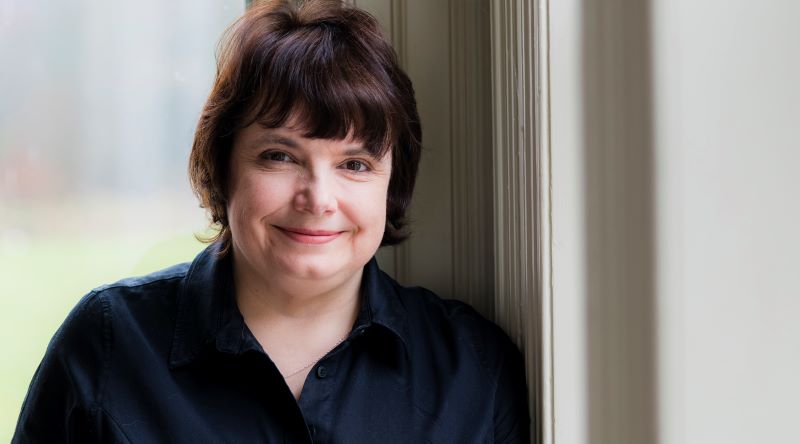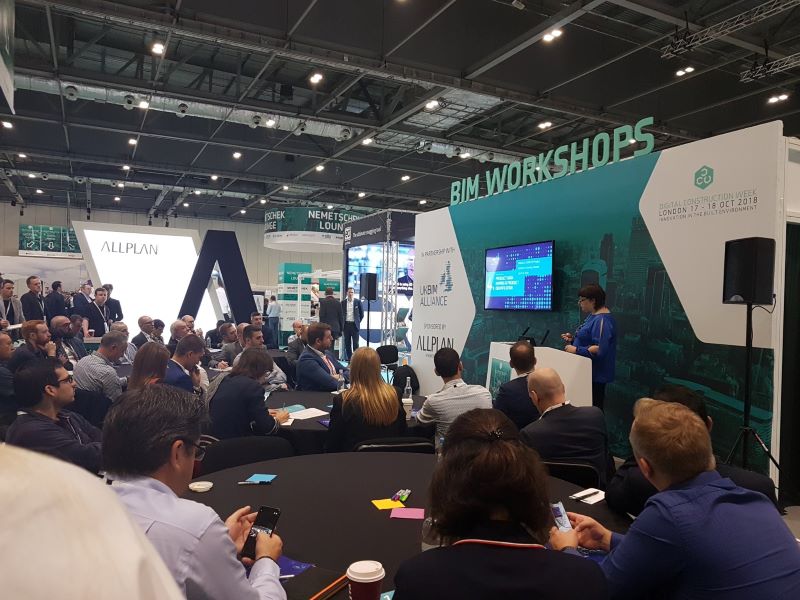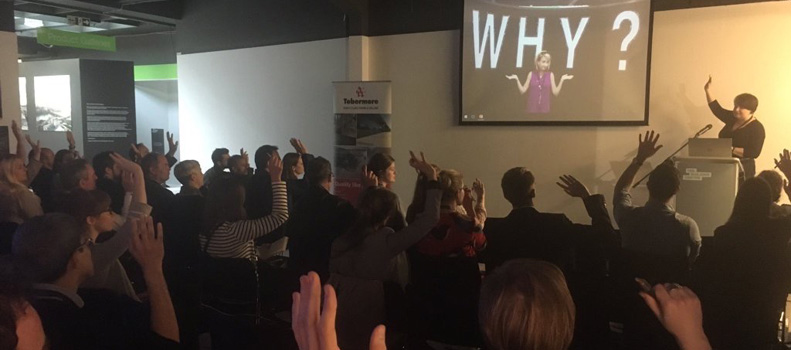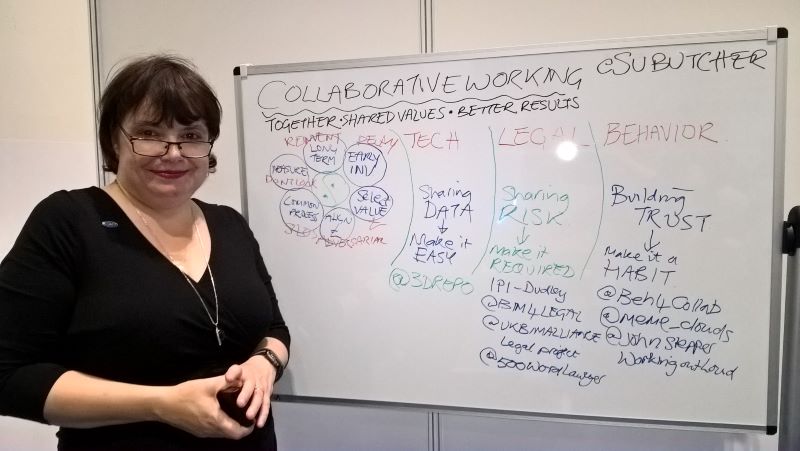Interview with Su Butcher, Director, Just Practising Limited
|
Photo credit: Claudia Gannon Photography. |
Su Butcher is the director of Just Practising Limited, a consultancy that helps construction product companies benefit from digital information management and communications. During her career, she moved from architecture to academia to operations and financial management, to marketing, and in 2011, she moved to digital consultancy.
In addition to celebrating the 10th anniversary of her consulting business, Butcher has been actively involved with numerous noteworthy projects in 2021. In July, she project managed the launch of the BIM for Housing Associations (BIM4HAs) toolkit. In September 2021, she will be chairing the Resilience First webinar, Lessons Learnt for the Built Environment from the Grenfell Tower Fire. The Manufacturers Plain Language Guide to Digitisation, which she wrote with the IET, will be published in September as well.
Designing Buildings Wiki caught up with Butcher to get her views on the evolution of her career, the impact of tragic events on the built environment and the importance of digitisation within the construction sector.
| DBW: What does your role involve day to day? |
Su Butcher (SB):
I’ve been working from home for over 10 years, so my routine has changed much less than it has for others during the pandemic. The last 18 months has been very different, nevertheless.
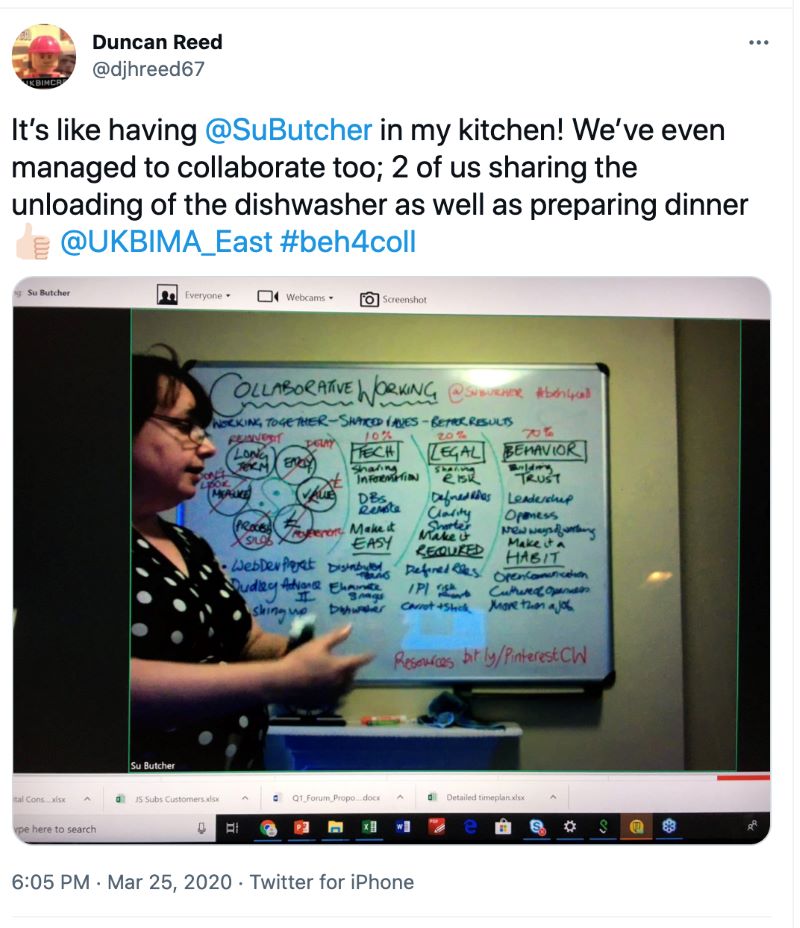 Tweet by Duncan Reed (25 March 2020) in his kitchen shows Su Butcher presenting a session about collaborative working. Tweet by Duncan Reed (25 March 2020) in his kitchen shows Su Butcher presenting a session about collaborative working.
|
At the end of 2020 I calculated that I’d had over 350 Teams and Zoom calls in the year, spoken at 40 virtual events and chaired or hosted over 30. There was also a lot of stepping in to keep clients’ crisis communications going when they furloughed their entire marketing departments! That’s all stopped now of course, and I am looking forward to attending some in person events again.
I’m currently project managing the BIM for Housing Associations Toolkit community, and the project “Digitisation for construction product manufacturers: a plain language guide” for the IET, so I’m heavily into getting things out the door, both writing, sub editing and converting disparate sources into readable, actionable text.
When I’m not doing that, I’m providing strategic advice to construction product manufacturers on digital media and digitisation generally, and writing technical copy, mostly for consumption online.
Most of my writing is done in the mornings, starting at around 8am. I’m definitely a morning person.
| DBW: How and where did your career begin? |
SB:
I studied to be an architect! It was my mum’s idea because I was very good at science and maths but also creative. I studied at the University of Liverpool School of Architecture and Building Engineering for both my degrees, working for a housing architect in the year out. Then the early 90s recession struck, and I spent five years running the first year design studio at the university and studying for a PhD in Architectural Education.
In 1997, I left the academic world and moved down to London to take up a career working for architects as a practice manager. I worked for three different firms which gave me a good grounding in marketing and business operations, which ultimately led to me setting up my own consultancy in 2011.
| DBW: What has been your career highlight so far? |
SB:
It’s very difficult to say because things just keep getting better and better and more and more interesting.
One thing I’m very proud of is that my client SIG Design and Technology (with whom I’ve worked for eight years) were highly commended in the Chartered Institute of Marketing’s Construction Marketing Awards for Best Use of Content Marketing in 2015. The previous three years had been spent converting the company’s traditional marketing and PR strategy into an integrated digital one. It brought great commercial benefit to the company, but for me as a non-marketer, it was being recognised for having helped make that happen. We didn’t win - that honour went to British Gypsum - but we celebrated like we had!
| DBW: What would you most like to change about the architecture, engineering and construction sector? |
SB:
The sector has a huge problem with information management, and pretty much all of my work over the last five years has been dedicated to helping our industry to digitise. In 2018 I chaired the working group that wrote the UK BIM Alliance Report, A Fresh Way Forward for Product Data: State of the Nation, which articulated what the problems were; many of them are still with us.
|
Su Butcher presenting the Product Data Working Group Report at Digital Construction Week, October 2018 (photo by Pam Bhandal, used with permission). |
I hope the work we are doing with manufacturers and housing associations will encourage better quality information to enter and leave the construction cycle. No more analogue rubbish in, rubbish out!
I’ve also been a huge advocate for collaborative working in construction. Unfortunately both behaviour and procurement are key barriers to effective collaboration, and until the industry realises the benefits it will be a niche topic I fear.
| DBW: Brexit, Grenfell fire, Carillion insolvency, COVID-19? Integration of technology/smart buildings? Climate change? Employee safety (non-COVID related) and security? Which of these events (or other news related event) has had the greatest impact on your career and why? |
SB:
Whilst the pandemic has a huge effect on me personally (I lost my mum in January 2021 to hospital acquired COVID), it is Grenfell, without a doubt, that has the greatest impact on my career. It has been both shocking and fascinating to watch how the industry is and isn’t responding to the challenge, and the appalling fallout in terms of challenges for tenants, homeowners and leaseholders, whilst conversely construction clients, manufacturers and contractors struggle to know how to change things.
I sincerely believe that a digitised system of information management will be the answer. It is not only more safe and secure, but also much more efficient and profitable.
|
Butcher is pictured presenting to a packed out Linkedin seminar at New London Architecture (The Building Centre) for Tobermore (photo by Claire Doyle, used with permission). |
Five years ago, I was spending most of my time showing construction product manufacturers how to benefit from using the Internet for communications. Now I spend most of my time showing them how to benefit from digitisation, because structured information is key to how they are going to keep their audience, be it architects and specifiers, contractors or users of their products.
I also believe that senior leadership in construction needs to change its attitude towards communications and be more open and honest with construction professionals and with the public about the journey we are on.
| DBW: What are your go to sources of knowledge when you research subjects that are new to you? Can you share your recommendations? |
SB:
Having spent a lot of time in the academic world, I’m very keen on original sources. If a story breaks or a new topic comes out, I like to go to the horse’s mouth first, and then to Wikipedia, Google, Twitter and LinkedIn to see what others are saying or have said in the past.
When the Grenfell tragedy happened, I was awake in bed listening to Radio 5 Live. Pretty quickly I was down on my computer googling and found the Grenfell Action Group blog – run by Edward Daffarn and Francis O’Connor. Ed memorably gave moving evidence to the Inquiry in April 2021.
The warnings Ed and Francis had given on their blog in the years running up to 14 June 2017 were all there on their blog that morning – and on that same day they linked them all via a new post.
My googling also led me to the case studies the participants in the refurbishment project had published on their websites. Most of them were deleted in the hours following, but of course you cannot delete on the Internet. I recorded some of the deleted pages on a Pinterest board, and of course pretty soon they were all over the media as others did the same. This sort of research relies heavily on Google Web Cache and the Wayback Machine.
| DBW: What is the most valuable professional advice you’ve received? What advice would you give? |
SB:
About a year after I set up my consultancy, Nick Pauley recommended I read The Consulting Bible by Alan Weiss. It made me realise that I didn’t want to set up a company to employ loads of people; I wanted to set up a business as an individual. I had seen the challenges of employing people and knew it wasn’t where I wanted to focus my efforts.
|
Butcher is pictured after presenting at Digital Construction Week 2018 (photo by Pam Bhandal – used with permission). |
Making that decision has made me a free agent, able to pivot to new ways of working and forms of work as the industry changes its appetite for digital. It has also meant that I’ve been able to work in distributed teams around the world, on websites, publications and events. I’ve never regretted it.
My advice to others is keep your ears and eyes open. Always look ahead to what is coming and how you can help the people around you cope. We are going to be experiencing a lot of changes in the coming decade – don’t wait to try something new!
| DBW: Is there anything else you’d like to share with our audience? |
SB:
After 10 years in consulting, I’m really looking forward to the next 10, which will no doubt be very different. There is much to be done, so let’s get stuck in.
This article is based on Su Butcher's written responses submitted on 11 August 2021. Butcher can be reached via email at [email protected] or through social media (on LinkedIn or Twitter).
To be interviewed for Designing Buildings Wiki, please send the editor an email.
[edit] Related articles on Designing Buildings Wiki
- BIM.
- Construction marketing.
- Digital information.
- Digitalisation in Construction.
- Digital technology.
- Digitisation.
- Grenfell Tower fire.
- List of interviews.
- Review of Industry Digitisation.
- UK BIM Alliance.
- UK digital strategy.
[edit] External resources
- Alan Weiss, The Consulting Bible.
- Construction Marketing Awards.
- Institution of Engineering and Technology, Subscribe to Manufacturers’ Product Data: a plain language guide.
- Grenfell Action Group blog.
- Grenfell Action Group, Grenfell Tower Fire.
- Grenfell Tower Inquiry, Bereaved, Survivors and Residents evidence 21 April 2021.
- National Housing Federation, Building Information Modelling (BIM): what is it and how can it help housing associations?
- Resilience First webinar, Lessons Learnt for the Built Environment from the Grenfell Tower Fire.
- Su Butcher, Deleted Grenfell Towers Pages.
- Su Butcher, Just Practising: 2020 in Review.
- UK BIM Alliance, A Fresh Way Forward for Product Data: State of the Nation.
- Wayback Machine.







